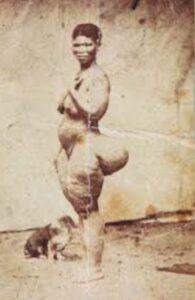
Photographs withstand the test of time to represent history; whether that be important people, ideas, scientific findings, etc. Photographs are tools to help teach us of the past so we can learn to not repeat our mistakes. Photographs can also be used for harm and hurt other people or cultures, including cultural appropriation. Cultural appropriation by definition is the adoption of an element(s) of one culture or identity by members of another culture or identity in a manner perceived as inappropriate or unacknowledged. This can be especially controversial when members of a dominant culture appropriate from minority cultures. In this specific instance, we will be discussing potential cultural appropriation through photographs, specifically photographs of Sarah Baartman and Kim Kardashian.
Sarah or Saartjie Baartman was a Khoikhoi woman who was persuaded to travel from South Africa to England by the ship doctor William Dunlop. To many in England, she was viewed as an anthropological freak and displayed as a sexual curiosity in exhibitions. Baartman became an object of scientific and medical research, continuously on exhibit until her death in 1816. Baartman’s dying wish was for her remains to not be exhibited and for her body to no longer be on display. Unfortunately, a museum in Paris did not listen and pickled her brain and genitals to keep them on display after her passing. Her body remained on display as late as 1985. On May 3, 2002, Sarah Baartman was welcomed back to Cape Town through a moving ceremony where she will rest in peace for eternity.

Kim Kardashian is a reality television star, a clothing brand owner, a skincare brand owner, an icon in modern American society, and notably known for her curvy figure. In November 2014, Kim Kardashian posed for Paper Magazine’s “Break the Internet” issue. She had previously posed nude or somewhat nude for several other magazines and articles but these photos are recognizably similar to photographs of Sarah Baartman. Both of these women are known for their large breasts and buttocks and are posed nearly identical in these pictures; both in their positioning and lack of clothing. The main difference between these two photos is Baartman was forced to take these pictures and Kardashian did it voluntarily. While Sarah Baartman was exploited, Kim Kardashian was celebrated.

One could argue that Kim Kardashian’s “Break the Internet” photograph is culturally appropriating photographs taken of Sarah Baartman. Kardashian is predominantly of white ethnicity while Baartman is the exact opposite. Baartman was used for her body and taken advantage of in numerous regards while Kardashian is extremely wealthy and privileged. Furthermore, Kardashian did not acknowledge or credit Sarah Baartman or the suffering she had to endure, both during and after life. It is hard to believe that neither Kardashian or anybody on her team had heard of or seen pictures of Baartman.
Sarah Baartman has become an icon in African history, honored by many women who have faced oppression and discrimination in their lives. Her story will forever live on through these photographs, continuously reminding people of the trauma and exploitation she faced. Is Kim Kardashian playing a part in her story being forgotten? Can this be considered a form of cultural appropriation? Should Kim Kardashian and her team have been aware of Baartman’s history and suffering? If this is a case of cultural appropriation, how should Kardashian and her team remedy this issue?








You did a great job covering this very interesting topic! I think it is hard to truly pinpoint if this was a picture to “Break the Internet” because of how Kim Kardashian is posed and dressed, or if it is because it is so similar to Saartjie Baartman and how she was on display to the world. Whether or not this was intentional it should have been more of a lesson and an outward education to people of who Saartjie Baartman is, and her lack of body autonomy even after passing away. I also think this topic explores the choice of either leaning into the stereotypes of women that will get them views through highlighting physical features or highlighting these physical features as a form of reclamation over her body and the narrative over that. While I do not think it was intentional on Kim Kardashian’s part, I do think her team made this intentional as a talking point to get conversation about her started.
Very interesting article, Olivia! Reading about Baartman’s story is absolutely heartbreaking knowing that her dying wish was to not exhibit her body on display and museums went directly against it. Even after death, her body was still used as an object for people’s amusement, and she was unable to truly rest until 2002. I had never seen Kim Kardashian’s cover photoshoot for Paper Magazine, but I completely agree with you that there is no way she or anyone on her team did not know about Baartman and the similarities between her and Kim. The photoshoot is a slap in the face toward a young woman who was put on display her whole life and many years after. While Baartman suffered, Kim has lived in luxury and disrespects Baartman by posing like her for a photoshoot. I’m not too convinced that this is considered cultural appropriation since Kim is not exactly adopting elements of a culture; instead, it is more that she is mocking a woman who was unwillingly perceived as a sexual curiosity rather than a culture as a whole. This does not make it any less wrong, but I do not think I would classify it as cultural appropriation. Overall, I really enjoyed reading this article, and the questions you asked at the end made it more interactive for discussion!